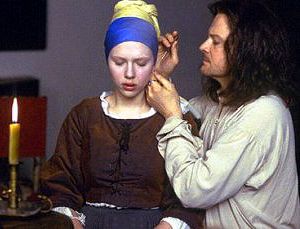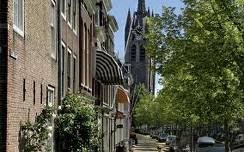Beside the Vleeshal, now known as The Koornbeurs, sea fish was and nowadays is traded (since the Middle Ages) untill this day and this has not changed.
MYLIFEFULLOFDREAMS! BLOG TO INSPIRE! I LOVE ITALY, VENICE AND OF COURSE THE NETHERLANDS: Delft, Hoorn, Elburg, Coevorden, Zandvoort Woerden! I love to paint and to make nice pictures!
maandag 31 januari 2011
Visbanken, Delft!
There were once three places where fish could be traded. These layers on or near bridges where fish could be easily rinsed with water and boats where fishermen could come from.
Fishermen of Delfshaven that belonged to the city of Delft, sold their fish on the Kaak Bridge, between Cameretten and Wijnhaven. River fish was traded on the Jerome bridge near the Oude Delft.
Beside the Vleeshal, now known as The Koornbeurs, sea fish was and nowadays is traded (since the Middle Ages) untill this day and this has not changed.
Beside the Vleeshal, now known as The Koornbeurs, sea fish was and nowadays is traded (since the Middle Ages) untill this day and this has not changed.
zondag 30 januari 2011
zaterdag 29 januari 2011
vrijdag 28 januari 2011
donderdag 27 januari 2011
Hotel des Indes!
Hotel Des Indes is a luxurious 5-star hotel on the Lange Voorhout in the city centre of The Hague. There is an exclusive Health Club with a swimming pool.
The hotel rooms are elegant in style and have a seating area, satellite Tv and a bathroom with bath. The large beds with soft white duvets offer a comfortable setting for your night's rest.
Hotel Des Indes was designed by the famous architect Jacques Garcia. There is also a lounge, restaurant and meeting facilities.
dinsdag 25 januari 2011
Vincent van Gogh!
 |
| Irises |
 |
| Cafe Terrace |
 |
| Orchard Blossom |
 |
| View of Auvers |
 |
| Boulevard Clichy To see more: http://www.vangoghmuseum.nl/ in Amsterdam. |
maandag 24 januari 2011
zaterdag 22 januari 2011
Famous hotel Kurhaus, Scheveningen!
The Kurhaus is a prominent building located in Scheveningen, The Hague in The Netherlands .
It was built between 1884 and 1885 by the German architects Johann Friedrich Henkenhaf and Friedrich Ebert (architect). It consisted originally of a concert hall and a hotel with 120 rooms. Having suffered serious damage by fire, it was rebuilt between 1886 and 1887. The ceilings were painted by the Brussels artist Van Hoeck and his large workshop. Several kings and heads of state sojourned in the Kurhaus during its heyday. Until the 1960s the Kurhaus remained an attraction to the public by the many performances of top artists. One of the last performances was by the Rolling Stones in 1965.
Fallen into disrepair and closed in 1969, the Kurhaus was saved from demolition in 1975 by being listed as a historical building. It is now completely renovated into the high-class Steigenberger Kurhaus Hotel (the only hotel in the Netherlands of the German hotel chain Steigenberger Hotel Group) and casino.
 |
| Where you can have a delicious High Tea with a direct view on the North Sea! |
vrijdag 21 januari 2011
donderdag 20 januari 2011
Malcesine, Lake Garda!
One day in summer we were in Malcesine. It was very hot, 34 Celsius. Most people, mainly tourists, were sitting near the water or in the shade of the restaurants. Malcesine is a beautiful little village near Lake Garda, where you also can take a bus boat to the other side of the lake.
Malcesine is a comune (municipality) in the Province of Verona in the Italian region Veneto, located about 120 km northwest of Venice and about 40 km northwest of Verona.
Malcesine lies on the shores of Lake Garda.
Its most prominent landmark is the Castello Scaligero, which has 13th-century fortifications and an older medieval tower. Remnants of an Etruscan tomb have been found within the castle walls. The castle was fortified by the della Scala family who ruled the region throughout the 13th century.
Other sights include the pieve of St. Stephen (8th century), the church of Santa Maria di Navene (11th century)
In 1786, Goethe was questioned by the local magistrate on suspicion of being a spy while drawing sketches of the castle.
Behind Malcesine rises the 1750 m-high Monte Baldo. Its summit is reachable through funivia, or cable car.
(bron: wikipedia)
 |
| Monte Baldo! |
woensdag 19 januari 2011
Milestones from the Roman period!
Near my home town old Roman milestones
have been found in excavations!
De mijlpalen stonden aan een Romeinse weg, die vanaf de kust bij Naaldwijk naar de Romeinse stad Forum Hadriani liep. Het was een standaard Romeins gebruik om langs de hoofdwegen om de Romeinse mijl een paal te plaatsen die de afstand naar de dichtstbijzijnde stad aangaf en bovendien de keizer eerde tijdens wiens regering de weg was aangelegd of gerepareerd. Hiervoor werd een lange inscriptie op de paal aangebracht met de naam van de keizer en al zijn eretitels. Aan de hand van de functies die een keizer een bepaald jaar bekleedde kan een mijlpaal gedateerd worden.
The milestones were on a Roman road leading from the coast near Naaldwijk to the Roman town Forum Hadriani. It was a standard Roman practice, along the main roads to the Roman mile pole for holding a distance to the nearest town and was also to honour the emperor during whose reign the road was constructed or repaired. For this was a long inscription on the pole providing the name of the emperor and all his honors. On the basis of the functions that an emperor held a given year a milestone is dated.
 |
| Milestone of Monster! |
 |
| Replica Roman milestone found at the same place were it is standing now in The Hague, near Wateringen. |
dinsdag 18 januari 2011
maandag 17 januari 2011
The girl with the pearl earring! Johannes Vermeer! The movie!
A young peasant maid working in the house of painter Johannes Vermeer becomes his talented assistant and the model for one of his most famous works. The movie has been recorded also in Delft and you can see beautiful sights of Delft.
 |
 |
| Scene from the movie! |
 |
| Scarlett Johanson as The girl with the pearl earring! |
 |
| Painting of Johannes Vermeer! Girl with a Pearl Earring (Meisje met de parel) c. 1665-1667 oil on canvas 18 1/4 x 15 3/4 in. (46.5 x 40 cm.) Koninklijk Kabinet van Schilderijen Mauritshuis, The Hague |
Chaudfontaine!
zondag 16 januari 2011
Just a quote!
The story of the weeping camel!
The story of the weeping camel is een waar verhaal over het leven van een herdersfamilie in de Mongoolse Gobiwoestijn. Ze wonen in vilten tenten en houden schapen en kamelen. Als het voorjaar is aangebroken helpt het gezin bij de geboorte van de kamelenkalveren. Voor één van de kamelen is het een zware bevalling en met moeite komt een zeldzaam wit kalf ter wereld. De moeder verstoot haar jong echter en weigert melk en moederzorg te geven. Wanneer de hoop op verbetering vervlogen lijkt, worden de twee zoontjes van de familie door de woestijn op reis gestuurd om een muzikant te zoeken die het hoosh-ritueel kan uitvoeren. Zonder muziekritueel blijven de dieren langdurig huilen en zal een verstoten kalf doodgaan (Bron Bol.com)
A nomadic family in Mongolia’s Gobi desert faces a problem when a white camel colt is born in a difficult delivery and the mother rejects it. Repeated efforts by the extended family to get the mother to nurse the colt fail. The colt stands alone and cries for its mother. The family worries that the colt will not survive. Finally, Dude (Enkhbulgan Ikhbayar), the older boy, is sent to a nearby town to find a musician who can perform a “Hoos” ceremony.
Little Ugna (Uuganbaatar Ikhbayar) begs to go along. The two boys travel for miles across the desert, stopping at a neighbor’s yert, where Ugna is delighted by his first encounter with television. They travel on to the village, and then return home with word that a musician is on the way. A musical ceremony is performed in an effort to get the mother camel to accept her colt.
The Story of the Weeping Camel is a blend of documentary footage and narrative. Filmmakers Luigi Falorni and Byambasuren Davaa cast a real nomad family of herders and shot many of the events in the film as they occurred. The Story of the Weeping Camel was selected by the Film Society of Lincoln Center and the Museum of Modern Art for inclusion in the 2004 edition of New Directors/New Films. It also won the 2003 European Film Award. (Bron: Barnes & Noble)
zaterdag 15 januari 2011
Abonneren op:
Reacties (Atom)





































